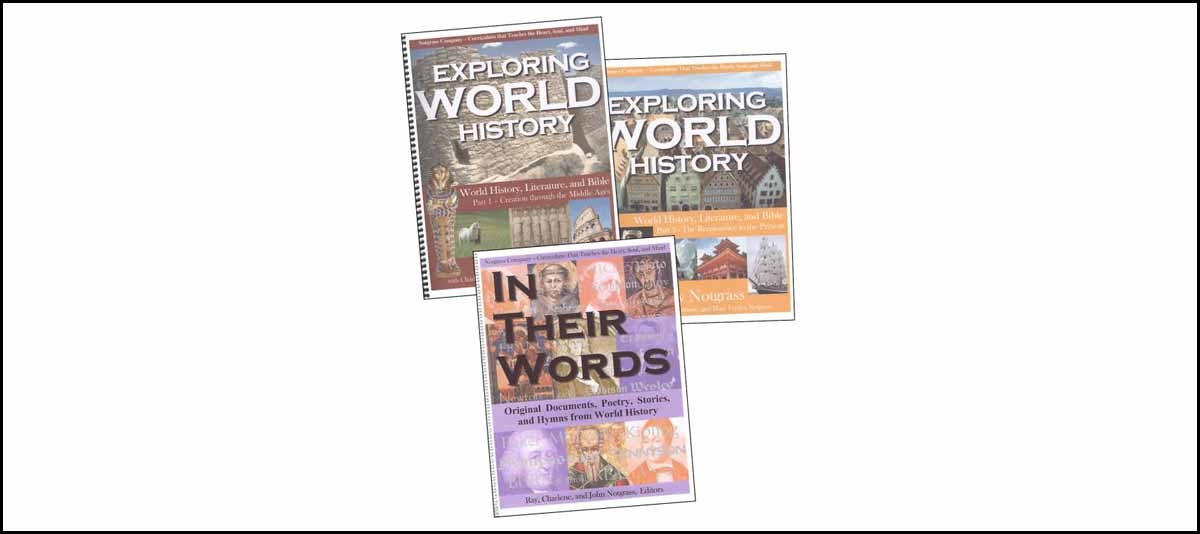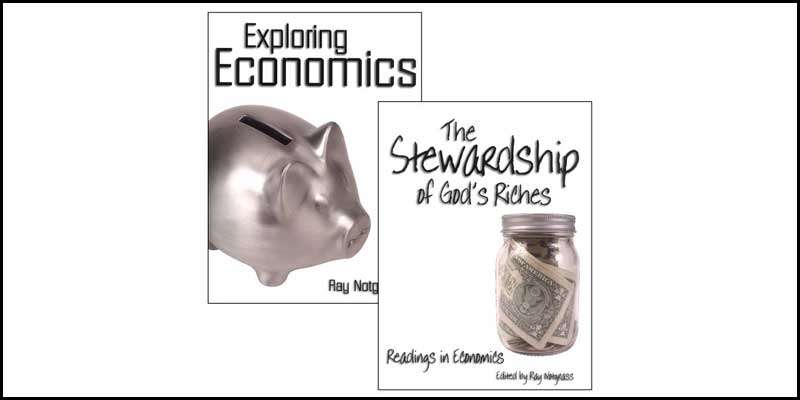 Studying world history alongside world literature has always made sense to me. Evidently it makes sense to the Notgrass family as well, because they’ve developed a well-organized curriculum that integrates these two subjects and adds a solid Bible component. The result is a three-credit [world history, English (world literature & composition), and Bible] high school level course that is strong in user-friendly features. Functioning either as an independent study course or a discussion-based study, the written-to-the-student curriculum manuals allow for as much or as little involvement as parents choose to give. There is a permeating emphasis on Bible history and story that provides a refreshing contrast to some studies of world history where the Christian is left with the impression that the Bible is not a historical document. The father/author, Ray Notgrass, assures us, however, that there is no denominational bias. The thirty weekly units each provide five lessons and cover history from creation to the present in two large coil-bound manuals (about 450 pgs. each): Part 1 – Creation through the Middle Ages and Part 2 – The Renaissance to the Present. Concentrating one day a week on spiritual applications, one lesson in each unit is a Bible study, but sometimes an entire unit focuses on a biblical time period (i.e., Unit #5, God chooses Israel). The units are organized with a consistent pattern that starts with an introduction to the unit – a brief overview, a list of books needed, the writing assignment choices, and an introduction to the book(s) to be read. Several types of lessons are incorporated into the units – historical overviews, key events, key concepts, key people, surveys of daily life and culture – in addition to the Bible study lesson mentioned previously. Each day the student is expected to read the lesson, work on writing assignments, and complete reading assignments. The “key” lessons seem a particularly effective way of compacting an in-depth historical understanding into a course that by its very nature (a one-year study) must be somewhat superficial. To get an idea of how this is accomplished, let’s take a look at Unit #10 – Roman Civilization. Unit lessons: (#46) The Rise and Fall of Rome; (#47) Key Person: Augustus Caesar; (#48) Key Concept: Roman Law; (#49) Everyday Life in Rome; and (#50) Bible Study: The Kingdom of God (contrasting with the Roman Empire). Books used in this unit: the Bible, selections from In Their Words (more about this later), and Julius Caesar by William Shakespeare. The writing assignment is a two or three page paper with a choice of subjects (short play, news article on the Caesar assassination). A last writing choice option is the Nation Project suggestion (again, more about this later). Each lesson is composed of highly readable, not-quite-story-form text; well-selected black and white illustrations; a Bible study question (to think about, discuss, or write a complete answer); and a Grammar Point (designed to provide a review for writing applications). Included at some point within each unit is a timeline (What Was Happening in the World?). The author suggests that most students will be able to successfully complete the course work in three hours per day.
Studying world history alongside world literature has always made sense to me. Evidently it makes sense to the Notgrass family as well, because they’ve developed a well-organized curriculum that integrates these two subjects and adds a solid Bible component. The result is a three-credit [world history, English (world literature & composition), and Bible] high school level course that is strong in user-friendly features. Functioning either as an independent study course or a discussion-based study, the written-to-the-student curriculum manuals allow for as much or as little involvement as parents choose to give. There is a permeating emphasis on Bible history and story that provides a refreshing contrast to some studies of world history where the Christian is left with the impression that the Bible is not a historical document. The father/author, Ray Notgrass, assures us, however, that there is no denominational bias. The thirty weekly units each provide five lessons and cover history from creation to the present in two large coil-bound manuals (about 450 pgs. each): Part 1 – Creation through the Middle Ages and Part 2 – The Renaissance to the Present. Concentrating one day a week on spiritual applications, one lesson in each unit is a Bible study, but sometimes an entire unit focuses on a biblical time period (i.e., Unit #5, God chooses Israel). The units are organized with a consistent pattern that starts with an introduction to the unit – a brief overview, a list of books needed, the writing assignment choices, and an introduction to the book(s) to be read. Several types of lessons are incorporated into the units – historical overviews, key events, key concepts, key people, surveys of daily life and culture – in addition to the Bible study lesson mentioned previously. Each day the student is expected to read the lesson, work on writing assignments, and complete reading assignments. The “key” lessons seem a particularly effective way of compacting an in-depth historical understanding into a course that by its very nature (a one-year study) must be somewhat superficial. To get an idea of how this is accomplished, let’s take a look at Unit #10 – Roman Civilization. Unit lessons: (#46) The Rise and Fall of Rome; (#47) Key Person: Augustus Caesar; (#48) Key Concept: Roman Law; (#49) Everyday Life in Rome; and (#50) Bible Study: The Kingdom of God (contrasting with the Roman Empire). Books used in this unit: the Bible, selections from In Their Words (more about this later), and Julius Caesar by William Shakespeare. The writing assignment is a two or three page paper with a choice of subjects (short play, news article on the Caesar assassination). A last writing choice option is the Nation Project suggestion (again, more about this later). Each lesson is composed of highly readable, not-quite-story-form text; well-selected black and white illustrations; a Bible study question (to think about, discuss, or write a complete answer); and a Grammar Point (designed to provide a review for writing applications). Included at some point within each unit is a timeline (What Was Happening in the World?). The author suggests that most students will be able to successfully complete the course work in three hours per day.
The Curriculum Package includes the two text manuals plus a 175-page compilation of original documents, poetry, stories, literature excerpts, and hymns from world history – In Their Words. These selections are continually used as reading assignments accompanying the lessons. The collection is impressive and completely indexed according to author, title, and subject. Again, illustrations are black and white. Additional reading assignments include Bible passages and fourteen full-length works: Mere Christianity (C.S. Lewis), The Cat of Bubastes (G.A. Henty), Julius Caesar (William Shakespeare), The Imitation of Christ (Thomas a Kempis), Here I Stand (Roland Bainton), Pilgrim’s Progress (John Bunyan), A Tale of Two Cities (Charles Dickens), Pride and Prejudice (Jane Austen), Heart of Darkness (Joseph Conrad), Pure Gold: Eric Liddell, The Hiding Place (Corrie Ten Boom), Animal Farm (George Orwell), and The Abolition of Man (C.S. Lewis).
Writing assignments are part of every lesson and unit. There is very little writing instruction other than a short “Tips on Writing” section in the manual. Rather, it’s assumed the student has mastered basic writing skills (a reasonable expectation for highschoolers) and is capable of taking the various suggestions and producing completed writing projects. As mentioned, the Grammar Points included with each lesson serve as reminders of writing mechanics. With timely feedback/critique, these writing assignments will provide a wealth of writing practice.
There are two “optional” parts of this world history program. The Nation Project is a series of research projects and writing assignments that allows the student to dig deeply into the story of one country of his choice. The suggested assignments (one option each week) cover a wide range of historical and cultural topics. A notebook/portfolio is the expected product of the completion of these assignments. The other option is the use of the Quiz and Exam Book. Acknowledging that some homeschoolers prefer to use alternative means of assessment, the Notgrass family has provided this book as a separate purchase. Included here are review questions for all lessons and literature selections as well as Unit Quizzes and Quarterly Exams. Quizzes and exams are multiple-choice, and while the book could be used as a consumable, it would also be quite easy to use a separate answer sheet and maintain the book as a non-consumable. The quizzes and exams are not reproducible. A complete answer key to all questions, quizzes, and exams is in the book.
Carving out an interesting niche among history and literature curricula, this course has much to offer. While not as demanding as the Omnibus courses, Exploring World History is academically strong, extremely biblically-centric, and very doable. While literature selections are well-chosen and interestingly integrated, literary analysis is minimal. In short, this would be an excellent choice for any family wanting a solid, integrated, and engaging history, literature, and Bible curriculum.
— Janice
Take a look at Exploring World History
![]() Download a PDF Sample of Exploring World History
Download a PDF Sample of Exploring World History
![]() Download a PDF Sample of Quiz & Exams
Download a PDF Sample of Quiz & Exams





